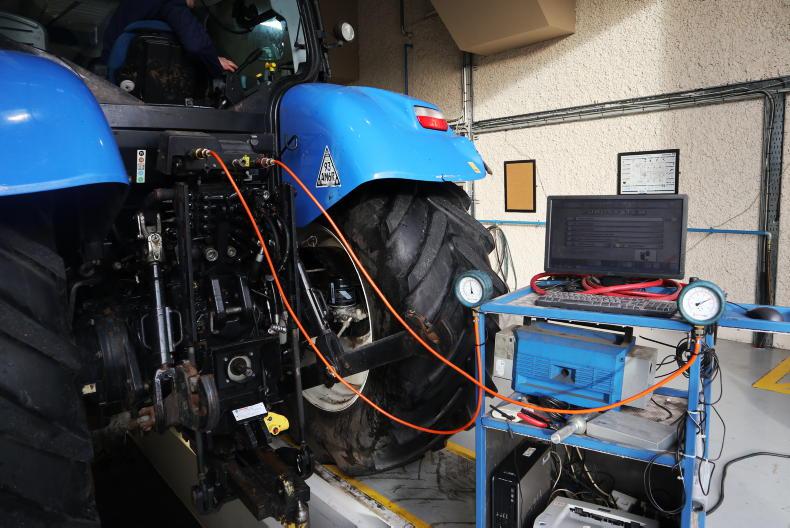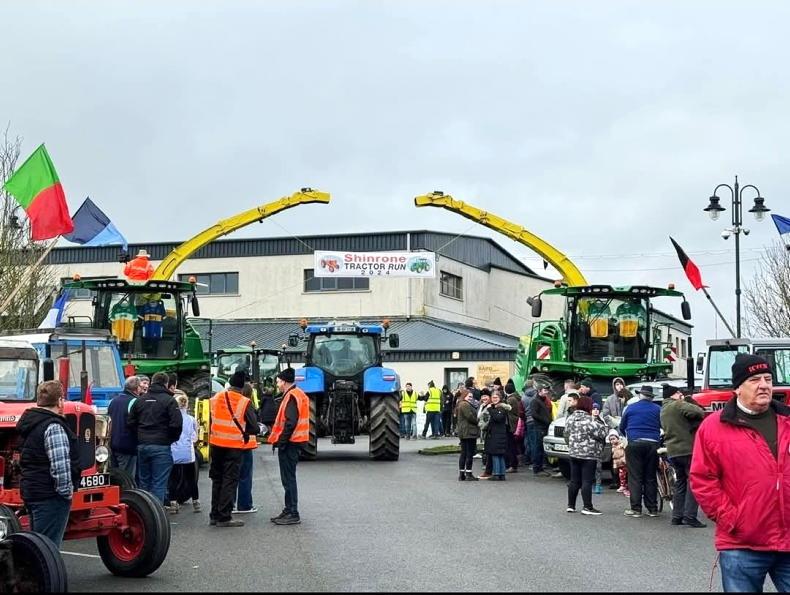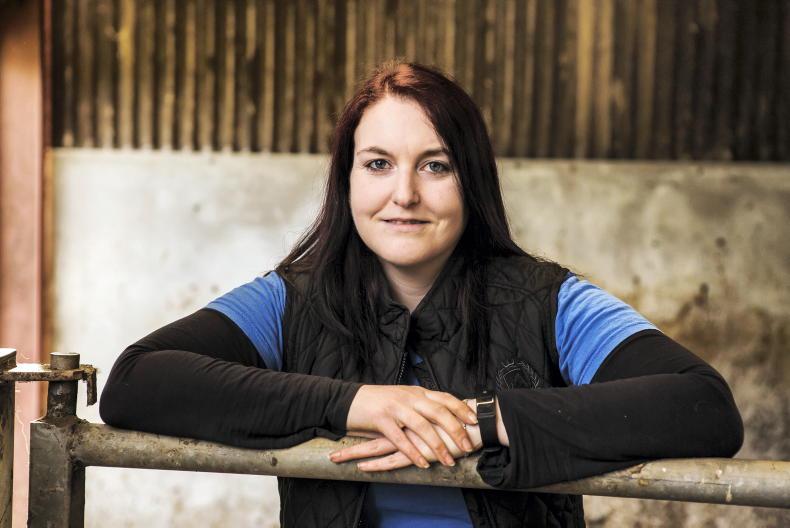After its launch in 2000, the New Holland flagship TM series soon went on to become one of the country’s most popular tractor ranges.
With models now between 14 and 21 years of age, the Basildon-built TM range remains a highly sought-after line-up of tractors, still serving both contractors and farmers of Ireland. Production stopped in 2007 to make way for the new range of T6 and T7 tractors.
Many units remain hard at work with hours in excess of 15,000, while some are touching on close to double that and are still going strong.
That said, low-hour examples are still out there, but are becoming extremely hard to come by and, as a result, tend to have a price tag reflecting their rarity.
The range today remains among Ireland’s most popular imported used tractors, the TM155 being one model in particular.

A TM135, one of the earlier model TM series tractors. \ Philip Doyle
Early models
The TM series was originally introduced as a successor to the earlier 60 series, which had been in production from 1996 to 1999, comprising of four models.
The 8560 was the flagship tractor at the time, having 160hp on tap. The all-new TM series was then initially showcased in late 1999, with units becoming available for purchase in 2000.
Originally, there were five models, spanning from 115hp to 165hp. A total of four transmission options were offered, depending on the model.
For example, the TM165 was only available with the newly developed full powershift Power Command transmission, which featured an automatic mode. The only other model offering the Power Command option then was the TM150.
Other transmissions included Shuttle Command (fully manual), Dual Command (power shuttle with single splitter) and Range Command (semi-powershift through three ranges of six gears).
Range Command proved to be by far the most popular transmission, with Irish dealers reporting that out of new sales at that time, 90% were fitted with the Range Command semi-powershift box.
What started out as a five-model series consisted of the TM115, TM125, TM135, TM150 and the range-topping TM165. This first generation of TM tractors retained the grey chassis and the fibreglass cab roof from the 60 series.
TM models still featured the firm’s own 7.5l PowerStar engines, but now with improved power and increased torque backup.
There was also a transition to the Electrolink Electronic Draft Control (EDC) system.
Models also featured a higher-geared starter motor. Minor changes inside the cab included new door frames and a fold-down passenger seat.

The TM135 was replaced in 2002 by the TM130.
Updates
Two years later, in 2002, New Holland updated its TM range. Alongside adding three new models, the TM140, TM175 (replacing the TM165) and TM190, existing models saw a slight change to their numbering, as well as a number of other small updates.
The TM125 was replaced with the TM120, the TM135 became the TM130 and the TM150 became the TM155.
The main updates here, aside from the new sticker design and plastic roof, was the introduction of viscous fan and intercooler, hydraulic engine tappets among other small engine changes and three-point linkage up/down on the gearstick.
Given the reduction of space in front of the radiators, the battery was relocated to the front of the right-hand cab step.
Chassis colour changed from grey to the black as we know it today. In 2004, all models changed to the more familiar yellow and blue bonnet stickers.
Range Command and Power Command models offered a higher level of specification, orientated towards the contractor and larger-scale operator.
As standard, these models offered cab suspension, a deluxe air seat, Terralock automatic 4wd and differential lock, 325l fuel tank, advanced three-point linkage control and a performance monitor.
Optional extras on Power Command and Range Command models included the SuperSteer 65° steering angle, a rarely chosen option, or the more common Terraglide front suspension, which in theory offered 105mm of front axle suspension.
TM owners over the years could never see much of a benefit in having the Terraglide front suspension.
A TM135 classic was also offered to provide farmers and contractors with good performance, albeit at a more affordable price.

Baling silage outside Rathfriland Co Down. \ Peter Houston
Reliability
As a whole, the TM range was and still is regarded as a straightforward reliable series, once correctly serviced and maintained.
For many, today the TM is regarded as a sweet spot in terms of electronics and mechanics. The good availability of parts and extensive knowledge of such machines remain a major attraction for owners.
However, some models were not without their issues. To be fair, any major issue found over the years was quickly addressed by the Essex-based firm.
The early TM175 and TM190 were two models that got off to a difficult start, which arguably affected their reputation ever since.
The problem with these early models was that they reportedly ran the back end too hot, which, over time, affected both the internals and wiring.
The manufacturer addressed this by fitting later models with a larger oil cooler, which was believed to be a substantial improvement.
That said, the majority of TM175s and TM190s worked trouble-free, while the ‘right one’ will still be quickly snapped up.
Depending on the application and operator, both the Range Command and Power Command transmissions have their issues too, like any transmission.
Many owners describe the Power Command transmission as power-hungry, although able to handle the higher horsepower better than Range Command models, partly why it was the only option on the long wheel base models.
Instead of using synchros like the Range Command box, it uses a number of clutch packs. These clutch packs, if not minded, will become jumpy, noticeable between gears six and seven and 12 and 13, especially under load.
It isn’t uncommon for the synchros to cause trouble in the Range Command models either – the earlier models in particular.
While Range Command was more popular new, there’s now always a customer for a Power Command model, one dealer noted.
The electric viscous fans fitted from 2003 onwards were prone to locking on fully. This explains why the majority of TMs are so loud, due to the fan running constantly at 100%.
Although cheaper now, a replacement viscous fan back when these tractors were new could have cost anywhere from €1,200 to €1,600. While many owners over the years opted to retrofit machines with the earlier non-electric fans, it never removed the error code.
It is recommended that the head gasket is done between 8,000 and 10,000 hours for peace of mind.
It is also advised to replace brakes when buying secondhand to prevent any unwanted trouble.
After that, the range was regarded as a straightforward simple tractor if cared for correctly.
Used market
Like a number of modern working classics, clean examples are continuing to rise in value.
This can be put down mainly to two things - the rising cost of machinery and the fact a tidy example with reasonable hours are becoming harder to find. While all models proved popular, the TM155 and TM150 seemed to have the edge in terms of popularity.
In some cases, current prices that some examples are being traded at surpasses their buying price when new, with the right examples today commanding anywhere up to €50,000.
One New Holland dealer in the midlands reported that it recently sold a 2007 TM155 with 5,500 genuine hours on the clock for €42,000.
That tractor would have cost in the region of €38,000 to €40,0000 new.
After its launch in 2000, the New Holland flagship TM series soon went on to become one of the country’s most popular tractor ranges.
With models now between 14 and 21 years of age, the Basildon-built TM range remains a highly sought-after line-up of tractors, still serving both contractors and farmers of Ireland. Production stopped in 2007 to make way for the new range of T6 and T7 tractors.
Many units remain hard at work with hours in excess of 15,000, while some are touching on close to double that and are still going strong.
That said, low-hour examples are still out there, but are becoming extremely hard to come by and, as a result, tend to have a price tag reflecting their rarity.
The range today remains among Ireland’s most popular imported used tractors, the TM155 being one model in particular.

A TM135, one of the earlier model TM series tractors. \ Philip Doyle
Early models
The TM series was originally introduced as a successor to the earlier 60 series, which had been in production from 1996 to 1999, comprising of four models.
The 8560 was the flagship tractor at the time, having 160hp on tap. The all-new TM series was then initially showcased in late 1999, with units becoming available for purchase in 2000.
Originally, there were five models, spanning from 115hp to 165hp. A total of four transmission options were offered, depending on the model.
For example, the TM165 was only available with the newly developed full powershift Power Command transmission, which featured an automatic mode. The only other model offering the Power Command option then was the TM150.
Other transmissions included Shuttle Command (fully manual), Dual Command (power shuttle with single splitter) and Range Command (semi-powershift through three ranges of six gears).
Range Command proved to be by far the most popular transmission, with Irish dealers reporting that out of new sales at that time, 90% were fitted with the Range Command semi-powershift box.
What started out as a five-model series consisted of the TM115, TM125, TM135, TM150 and the range-topping TM165. This first generation of TM tractors retained the grey chassis and the fibreglass cab roof from the 60 series.
TM models still featured the firm’s own 7.5l PowerStar engines, but now with improved power and increased torque backup.
There was also a transition to the Electrolink Electronic Draft Control (EDC) system.
Models also featured a higher-geared starter motor. Minor changes inside the cab included new door frames and a fold-down passenger seat.

The TM135 was replaced in 2002 by the TM130.
Updates
Two years later, in 2002, New Holland updated its TM range. Alongside adding three new models, the TM140, TM175 (replacing the TM165) and TM190, existing models saw a slight change to their numbering, as well as a number of other small updates.
The TM125 was replaced with the TM120, the TM135 became the TM130 and the TM150 became the TM155.
The main updates here, aside from the new sticker design and plastic roof, was the introduction of viscous fan and intercooler, hydraulic engine tappets among other small engine changes and three-point linkage up/down on the gearstick.
Given the reduction of space in front of the radiators, the battery was relocated to the front of the right-hand cab step.
Chassis colour changed from grey to the black as we know it today. In 2004, all models changed to the more familiar yellow and blue bonnet stickers.
Range Command and Power Command models offered a higher level of specification, orientated towards the contractor and larger-scale operator.
As standard, these models offered cab suspension, a deluxe air seat, Terralock automatic 4wd and differential lock, 325l fuel tank, advanced three-point linkage control and a performance monitor.
Optional extras on Power Command and Range Command models included the SuperSteer 65° steering angle, a rarely chosen option, or the more common Terraglide front suspension, which in theory offered 105mm of front axle suspension.
TM owners over the years could never see much of a benefit in having the Terraglide front suspension.
A TM135 classic was also offered to provide farmers and contractors with good performance, albeit at a more affordable price.

Baling silage outside Rathfriland Co Down. \ Peter Houston
Reliability
As a whole, the TM range was and still is regarded as a straightforward reliable series, once correctly serviced and maintained.
For many, today the TM is regarded as a sweet spot in terms of electronics and mechanics. The good availability of parts and extensive knowledge of such machines remain a major attraction for owners.
However, some models were not without their issues. To be fair, any major issue found over the years was quickly addressed by the Essex-based firm.
The early TM175 and TM190 were two models that got off to a difficult start, which arguably affected their reputation ever since.
The problem with these early models was that they reportedly ran the back end too hot, which, over time, affected both the internals and wiring.
The manufacturer addressed this by fitting later models with a larger oil cooler, which was believed to be a substantial improvement.
That said, the majority of TM175s and TM190s worked trouble-free, while the ‘right one’ will still be quickly snapped up.
Depending on the application and operator, both the Range Command and Power Command transmissions have their issues too, like any transmission.
Many owners describe the Power Command transmission as power-hungry, although able to handle the higher horsepower better than Range Command models, partly why it was the only option on the long wheel base models.
Instead of using synchros like the Range Command box, it uses a number of clutch packs. These clutch packs, if not minded, will become jumpy, noticeable between gears six and seven and 12 and 13, especially under load.
It isn’t uncommon for the synchros to cause trouble in the Range Command models either – the earlier models in particular.
While Range Command was more popular new, there’s now always a customer for a Power Command model, one dealer noted.
The electric viscous fans fitted from 2003 onwards were prone to locking on fully. This explains why the majority of TMs are so loud, due to the fan running constantly at 100%.
Although cheaper now, a replacement viscous fan back when these tractors were new could have cost anywhere from €1,200 to €1,600. While many owners over the years opted to retrofit machines with the earlier non-electric fans, it never removed the error code.
It is recommended that the head gasket is done between 8,000 and 10,000 hours for peace of mind.
It is also advised to replace brakes when buying secondhand to prevent any unwanted trouble.
After that, the range was regarded as a straightforward simple tractor if cared for correctly.
Used market
Like a number of modern working classics, clean examples are continuing to rise in value.
This can be put down mainly to two things - the rising cost of machinery and the fact a tidy example with reasonable hours are becoming harder to find. While all models proved popular, the TM155 and TM150 seemed to have the edge in terms of popularity.
In some cases, current prices that some examples are being traded at surpasses their buying price when new, with the right examples today commanding anywhere up to €50,000.
One New Holland dealer in the midlands reported that it recently sold a 2007 TM155 with 5,500 genuine hours on the clock for €42,000.
That tractor would have cost in the region of €38,000 to €40,0000 new.












SHARING OPTIONS